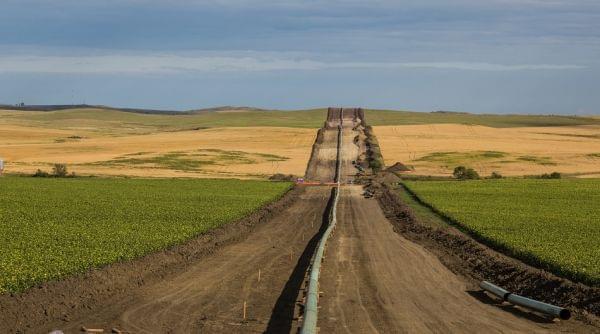Corps: No New Impacts Found In Dakota Access Pipeline Review

The Dakota Access Pipeline being installed between farms in 2016, as seen from 50th Avenue in New Salem, North Dakota. Tony Webster / Flickr
BISMARCK, N.D. (AP) — The U.S. Army Corps of Engineers on Friday completed more than a year of additional study of the North Dakota-to-Illinois Dakota Access oil pipeline, saying the work substantiated its earlier determination that the pipeline poses no significant environmental threats.
U.S. District Judge James Boasberg in June 2017 ruled that the Corps "largely complied" with environmental law when permitting the $3.8 billion, four-state pipeline built by Texas-based Energy Transfers Partners.
However, the judge also ordered more study because he said the agency didn't adequately consider how an oil spill under the Missouri River might affect the Standing Rock Sioux tribe's fishing and hunting rights, or whether it might disproportionately affect the tribal community — a concept known as environmental justice. It aims to ensure development projects aren't built in areas where minority populations might not have the resources to defend their rights.
In its initial analysis of the Missouri River crossing that skirts the northern edge of the Standing Rock Reservation along the North Dakota-South Dakota border, the Corps studied the mostly white demographics in a half-mile (0.8-kilometer) radius, which the agency maintained is standard. But if the Corps had gone another 88 yards (80 meters) — not quite the length of a football field — the study would have included the reservation.
The tribe accused the Corps of gerrymandering. The tribe believes an oil spill from the pipeline under the Lake Oahe reservoir on the Missouri River — from which the reservation draws its water — could have a detrimental effect on the tribal community. Standing Rock is leading a lawsuit joined by three other Dakotas tribes that seeks to shut down the pipeline.
The Corps said in its summary filed with the court Friday that the chances of an oil spill are low and any impacts to hunting and fishing "will be of limited scope and duration." On the environmental justice issue, the agency said minority populations, including the tribe, and low-income groups are not at greater risk of "adverse human health or environmental effects."
The more than 100-page analysis won't be released until a confidentiality review is completed, lawyers for the corps said in court documents.
Mike Faith Jr., the Standing Rock chairman, said the corps failed to take a fresh look at the risks as was ordered by Boasberg.
"Instead, we got a cynical and one-sided document designed to paper over mistakes, not address the tribe's legitimate concerns," Faith said in a statement.
He said the tribe is deciding on its next step.
Boasberg did not immediately rule on whether he was satisfied with the Corps' additional work. However, when he ruled last October that the pipeline could continue operating while the work was done, he hinted it might not take much.
The judge said at the time that he found it likely the Corps would be able to justify its previous decisions, and that the agency "must simply connect the dots" and not "redo its analysis from the ground up." He noted that the tribe's water intake has been moved about 50 miles (80 kilometers) downstream since pipeline construction began, and said an alternative river crossing near Bismarck that had been studied and rejected would pass much closer to a drinking water intake that serves tens of thousands more people.
The Standing Rock tribe and its supporters have maintained that the only lawful way to resolve the matter would be through a full environmental study that includes consideration of route alternatives. The Corps had planned to do a more thorough study before President Donald Trump took office in January 2017 and pushed through completion of the stalled project.
The pipeline has been operating since June 2017, moving oil from North Dakota through South Dakota and Iowa to a distribution point near Patoka, Illinois, from which it can be shipped to the Gulf Coast and potentially lucrative markets abroad. It has the capacity to move half of the oil produced daily in North Dakota, the nation's second-leading producer behind Texas.

